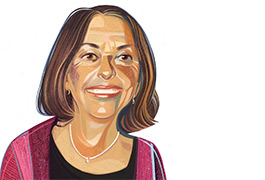A child’s autism often first comes to light because of his or her atypical language development and social communication skills — differences that researchers have found often later carry over to a younger (‘high-risk’) sibling.
Women are exquisitely tuned in to their babies’ vocal patterns, and studies have found that they intuitively foster their child’s language development by responding to the complex vocalizations — consonant babbles such as ‘ba ba,’ for example — that emerge by around 9 months of age.

Connecting matters: Helen Tager-Flusberg links autism science to society
Illustration by Ivan Canu
In a study last year, my colleagues and I investigated whether mothers of infants who have an older sibling with autism respond to their baby’s vocalizations in the same way that mothers of typically developing children do1.
Through this work, we aimed to better understand reciprocal patterns of vocalization between infants and their mothers, and how those relate to later language development. Our hope was that the results would help scientists develop treatments that encourage speech and language acquisition in children with autism.
What we found, however, was that women are highly attentive to their infants’ coos and babbles whether or not their older child has autism. Even women who have features of autism (but not autism itself) or who are depressed respond typically to their infants. So, whatever minor differences in language emerge in these infants do not stem from differences in mother-child communication.
We thought our findings were important and believed readers would see them as positive. But our work provoked some bitter reactions.
One blogger on a fringe autism news site described our study as “bullshit,” and a commentator on the blog questioned my colleagues’ and my credibility as scientists. These bloggers seem to think that any exploration into the interactions between mothers and their children is insulting. They saw us as blaming mothers for the language deficits of their children with autism. Nothing could be further from the truth.
Blame game:
The implicit message from these and other comments on our paper was that studying how women interact with their children with autism should be off-limits. But bending to this kind of criticism can be dangerous for science.
These sorts of reactions may represent an extreme view, but I do understand where the sensitivity to this type of work comes from. One of the field’s pioneers, Leo Kanner, first proposed in 1943 that ‘refrigerator mothers’ — who were cold and unemotional — might be to blame for their children’s poor social and language skill development. Although this theory has been fully discredited — even Kanner later distanced himself from the idea — the damage it wrought has not disappeared.
Too many women still hear from professionals, family and friends that perhaps they did or didn’t do something that caused their child to have autism. Many of the parents who have participated in our research over the years carry profound guilt about their child’s condition even when no one has directly accused them of contributing to it.
The scientific community is partly to blame for this message. Although scientists no longer view parental behavior as causing autism, biological and environmental investigations can implicate parents in various ways, though most have nothing to do with parenting style. Genetic studies tend to highlight the transmission of ‘risk’ genes from parent to child, parental age has emerged as an important demographic risk factor, and evidence is mounting that too much or too little activity from the mother’s immune system during pregnancy can raise the risk of autism in her child.
So it is no wonder some parents feel as if they’re to blame — in one way or another — for their children’s autism. But should the chance of making parents feel unnecessarily guilty stop scientists from conducting studies that explore the role of parents? My answer is no.
Two-way street:
Still, we autism researchers may want to consider how we communicate with the community that is so invested in our work. We need to better articulate what we are studying and why. Parents deserve great credit for pushing for more research funding and enticing leading scientists to turn their attention to autism, so they are justified in demanding a lot in return.
Years ago, I had concerns about studying mothers’ behavior. I entered the field at a time when psychoanalytic theories of autism still held currency. Like a growing number of researchers, I was convinced that autism was a neurodevelopmental disorder that could only be understood by studying children’s minds, brains and behavior. I left mothers out of my early studies of language in children with autism. In doing so, I managed to avoid blaming parents, but I neglected to appreciate the dyadic nature of communication.
Studying the other side of that exchange — the mothers who are interacting with the babies — is critical. After all, communication is a two-way street. And understanding what happens in that interaction may provide clues about how language develops in children with autism and for refining early-intervention strategies for those infants at risk of developing the condition. It might even relieve some parents’ guilt.
In another study published last year, we found that mothers of high-risk infants actually gesture more than usual to their 1-year-old babies, providing rich communication2. Far from concluding that women who have children with autism don’t support their infants’ developmental needs, our work suggested that they use lessons from early behavioral intervention to raise their later-born children.
Criticism of mainstream autism research, especially studies that put the focus on parents, is likely to continue. As long as the science is justifiable, however, scientists should not shy away from studying sensitive topics that have the potential to illuminate autism.
This article was originally published by a www.thetransmitter.org . Read the Original article here. .



